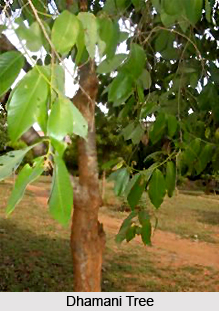 Dhamani is a deciduous tree of medium size. The botanical name of this tree is Grewia Tiliaefolia Vahl. It is also called Pharsa in Bengali language. This tree is known in different names in Hindi language like Dhamani, Dhamin, Phalsa and Pharsa. In Sanskrit language this tree is called as Dhanurvrik-Sha, Dhanurvksah and Dharmana. There are various other names by which this medicinal tree is called like Sadachi, Tarra and Unu in Tamil language and Charachi, Ettatada, Jana, Nulijana, Tada and Udupai in Telugu language. In Konkani language this tree is known as Butale, Dadsale and Danioni and in Malayalam it is called Chadicha, Satachi and Una.
Dhamani is a deciduous tree of medium size. The botanical name of this tree is Grewia Tiliaefolia Vahl. It is also called Pharsa in Bengali language. This tree is known in different names in Hindi language like Dhamani, Dhamin, Phalsa and Pharsa. In Sanskrit language this tree is called as Dhanurvrik-Sha, Dhanurvksah and Dharmana. There are various other names by which this medicinal tree is called like Sadachi, Tarra and Unu in Tamil language and Charachi, Ettatada, Jana, Nulijana, Tada and Udupai in Telugu language. In Konkani language this tree is known as Butale, Dadsale and Danioni and in Malayalam it is called Chadicha, Satachi and Una.
Dhamani is actually a small to medium-sized deciduous tree which is about seven meters tall with smooth greyish-brown, vertically fissured bark and pubescent twigs. The leaves are seven to twelve centimetres long and five to seven centimetres wide, generally ovate or orbicular, upper surface glabrous or minutely stellately hairy, lower surface is hoary-tomentose, apex acuminate, margins crenate-dentate. The base is cordate and unequal, usually five-nerved, petioles are 0.5 to 1.8 centimetres long, pubescent; stipules are 0.7 to 1 centimeters long, lanceolate, leafy, auriculate, with a rounded lobe on the lower side. The flowers of this tree are small, yellow, umbellate, tomentose, in axillary of four to eight flowered cymes; sepals are eight millimetres long, oblong, pubescent outside; petals are about half as long as sepals, oblong or spathulate, entire or notched; gland about one-third the length of the petal, densely white-villous on the margin. The fruit of this tree is an edible drupe about 0.7 centimetres in diameter, black, globose or indistinctly two to four lobed; stones one to two celled. This tree bears flowers and fruits in between the months of May and October in central India. It occurs naturally in east tropical Africa, India, Bangladesh, Nepal, Myanmar (Burma) and Sri Lanka. In India, Dhamani is found in deciduous forests in the sub-Himalayan region from the Jumna eastwards to Nepal and Bihar, and southwards through peninsular India to Tamil Nadu.
The powdered stem bark of this tree is taken in small doses to treat dysentery. Among the tribal inhabitants of the district of Prakasam in the southern parts of Andhra Pradesh state, a paste of the powdered stem bark mixed with sugar and milk is given to treat diarrhea. The root bark is applied externally to relieve cow-itch. Mucilage obtained by washing the root bark with water is given with millet (Panicum miliaceunr Poaceae) flour as a remedy for dysentery in the Konkan. The powdered wood is emetic, and the same is used as an antidote to opium poisoning.



















